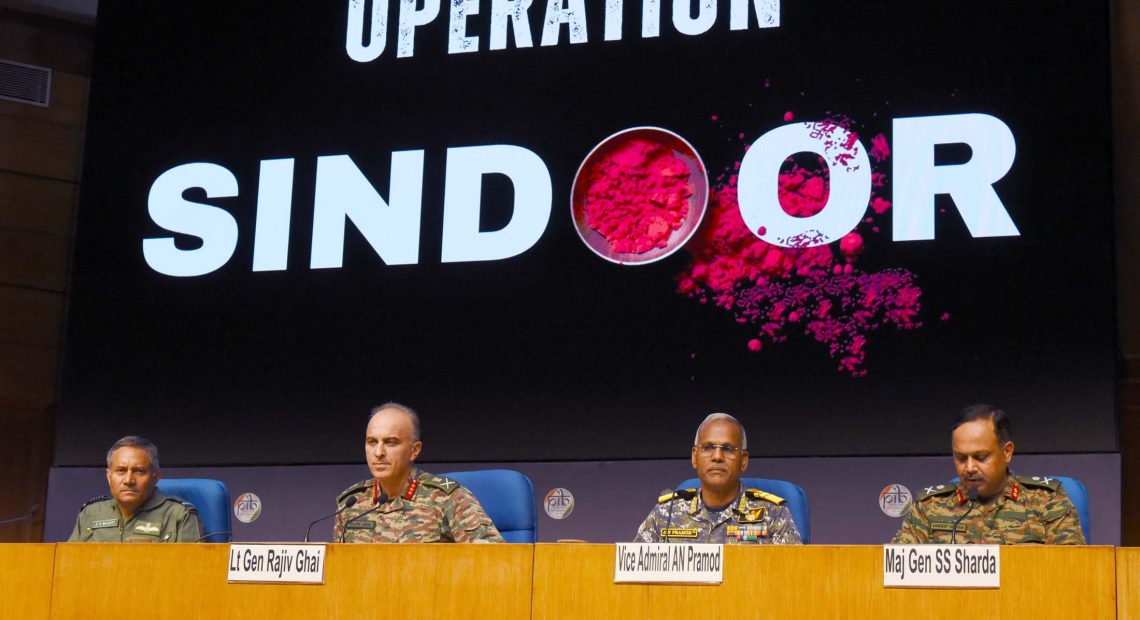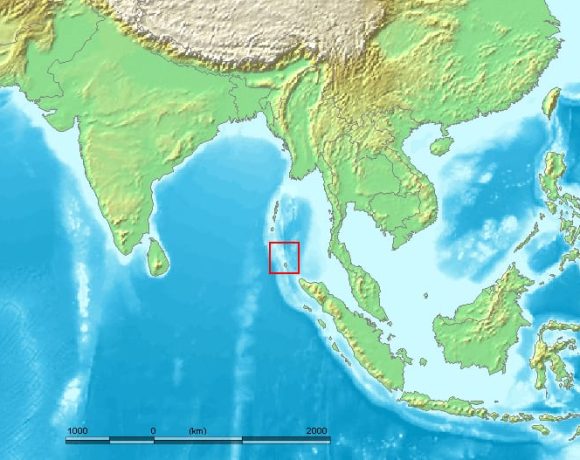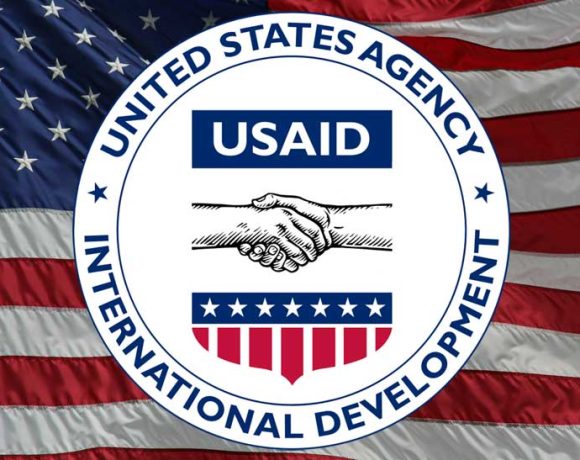
Breaking Down The News: Key Takeaways from the DGMO Press Briefing on Operation Sindoor
In one of the most significant military briefings in recent history, India’s top brass from the Army, Air Force, and Navy came together to tell the nation what really happened during Operation Sindoor. This wasn’t just another statement — it was a declaration of intent. The Indian military didn’t just respond to a terror attack in Pahalgam that killed 26 civilians on April 22 — it struck back with precision, restraint, and devastating impact. Here’s a breakdown of what was revealed, simplified for every Indian reader.
It all began with blood — the terror attack on innocent tourists in Pahalgam. What followed was Operation Sindoor, a multi-domain retaliatory campaign that saw India take the fight deep into Pakistan’s terror networks. Lieutenant General Rajiv Ghai, Director General of Military Operations, explained that after identifying over a dozen active terror camps, nine were found to still be operational. Some had been emptied in fear of retribution, but nine remained live targets — and those were the ones that were hit.
The results? Over 100 terrorists were eliminated, including high-value masterminds. Among them was Yusuf Azhar, one of the men behind the 1999 IC-814 hijacking. Also killed were Abdul Malik Rauf, a handler in Lashkar-e-Taiba’s deep network, and Mudasir Ahmed, one of the architects of the Pulwama bombing. These weren’t low-level operatives. These were the men whose names have echoed in India’s list of most-wanted terrorists for over a decade.
The terror camps targeted were not some makeshift huts. They were concrete training centers with watchtowers, dormitories, and hardened perimeters. The most infamous among them was Muridke, Lashkar-e-Taiba’s main base, the very place that radicalized Ajmal Kasab. The second was Bahawalpur, Jaish-e-Mohammed’s breeding ground for suicide bombers. The Indian Air Force struck both camps with surgical precision. Using air-to-surface guided munitions, they deployed payloads that tore through the roofs and obliterated interiors. The DG Air Ops, Air Marshal A.K. Bharti, showed slides proving how one weapon after another hit exact points — red buildings, courtyards, dorms. The enemy had no time to react. It was over before they knew it had begun.
But Pakistan didn’t take it lying down. Within hours of India’s strikes, they launched drone swarms, sending UKAB drones, quadcopters, and surveillance UAVs into Indian airspace. From Srinagar to Naliya, they tried to hit Indian military and civilian infrastructure. But India was ready. Every drone wave was intercepted — either by Pechora missiles, Akash systems, legacy air defense guns, or even snipers in the forward bases. And yet, India didn’t escalate. It responded with calibrated precision, targeting only military sites like radar installations in Lahore, Gujranwala, Chhuniya, and SAM sites in Malakand.
Things changed when Pakistan crossed a red line — they let civilian aircraft fly from Lahore airport while drone attacks were ongoing. It was a thinly veiled attempt to use human shields. India, even at the cost of tactical disadvantage, refrained from targeting those zones. But the line had been crossed. India escalated, not in rhetoric, but in firepower.
The Indian Air Force struck hard across Pakistan’s military landscape. Key hits included:
-
Chaklala Airbase (Islamabad) – strategic air hub, bombed.
-
Sargodha Airbase – where F-16s are stationed, runways cratered.
-
Rahim Yar Khan UAV hangars – destroyed.
-
Sukkur and Bolari airfields, Jacobabad aircraft shelters – bombed.
-
Multiple radar towers were “decapitated”, in the Air Marshal’s words.
Visual proof was presented: collapsed hangars, smoking radar heads, blown runways. The strikes were specific. Nothing civilian was hit.
While the Indian Air Force dominated the skies, the Indian Navy quietly tightened the noose at sea. Vice Admiral A. N. Pramod, Director General Naval Operations, revealed that within 96 hours of the Pahalgam attack, India had deployed its carrier battle group, submarines, and maritime strike forces across the northern Arabian Sea.
The Navy’s objective was two-fold: maintain battle-space transparency and apply strategic maritime pressure on Pakistan’s western coast. With Pakistani naval units forced to remain close to their harbors, the threat of a strike on Karachi remained imminent. While the Navy refrained from kinetic action, its presence was enough to tilt the psychological edge. As the Vice Admiral put it, “Pakistan knew what we were going to do, if they dared.”
And dare they did — again.
On the morning of May 10, the DGMO received a hotline message from his Pakistani counterpart proposing a ceasefire. India agreed, effective from 5 PM that evening. But predictably — and as the DGMO himself said, “disappointingly but not surprisingly” — Pakistan violated the agreement within hours, launching fresh drone intrusions and LoC firing by 7 PM the same day.
India issued another warning through the hotline: repeat this, and the response will be fierce and punitive.
India’s political and military leadership remains firm. The Chief of Army Staff has granted full authority to field commanders to strike back at any violations without waiting for fresh clearance. That means the Indian response hereafter will be swift, local, and crushing.
And for those wondering, did India suffer losses? The Air Marshal answered without blinking:
“All our pilots are back. Our objectives were achieved. That’s all that matters.”
Rumors of Rafales being downed were dismissed. Losses, if any, were acknowledged as part of warfare, but without specifics — so as not to aid the adversary.
As for Pakistan’s losses — besides the 100+ terrorists, the Army confirmed 35–40 Pakistani military personnel killed along the LoC between May 7 and May 10 in artillery engagements. Their drone fleets have taken significant damage. Radar coverage degraded. And their terror camps? Leveled.
This wasn’t just a retaliatory mission. It was a message. A message that India can strike with precision, patience, and strength — across domains, across the border, across the sea.
And that justice, at long last, has been served.
DGMO Press Conference on Operation Sindoor – Full Summary
1. Opening Remarks by Moderator:
The press conference commenced with a formal introduction of the three senior officers leading the briefing:
-
Lt. Gen. Rajiv Ghai, Director General of Military Operations (DGMO) – land operations.
-
Air Marshal A.K. Bharti, Director General Air Operations – air campaign.
-
Vice Admiral A. N. Pramod, Director General Naval Operations – maritime response.
2. Lt. Gen. Rajiv Ghai (DGMO) – Army Perspective:
-
Described the Pahalgam terror attack (April 22) as a brutal act killing 26 civilians.
-
Declared it was time to make a “compelling statement of national resolve.”
-
Operation Sindoor was launched to punish the perpetrators and destroy terror infrastructure.
-
Terror camps were selected based on microscopic intelligence analysis; many had already been vacated in fear.
-
Emphasized India’s self-imposed restriction to only target terrorists and avoid collateral damage.
-
Nine camps were selected: some in Pakistan-occupied Jammu & Kashmir (PoJK), others in Punjab province (e.g., Muridke, the Lashkar-e-Taiba stronghold).
-
Stated that the strikes achieved “total surprise,” eliminating over 100 terrorists, including Yusuf Azhar, Abdul Malik Rauf, and Mudasir Ahmed, all involved in major past attacks like IC-814 hijack and Pulwama.
-
Highlighted Pakistan’s reckless retaliation targeting civilian sites including Gurudwaras, in contrast to India’s precision.
He handed over to the Indian Air Force to explain the aerial operations.
3. Air Marshal A.K. Bharti – IAF Operations (Part 1):
-
Stated IAF was tasked to strike Bahawalpur and Muridke training camps, deep inside Pakistan.
-
Emphasized precision targeting using air-to-ground guided munitions to minimize collateral damage.
-
Shared detailed before-and-after visuals of impact points, showing buildings at both camps destroyed with pinpoint accuracy.
-
Reiterated that the IAF only hit terror infrastructure, not any Pakistani military assets.
-
Said that on the night of May 7, after the IAF strikes, waves of drones and UAVs from Pakistan attempted to target Indian military and civilian areas.
-
All incoming UAVs were successfully intercepted with hard kill and soft kill counter-drone systems.
-
Despite provocations, India continued to show restraint and only responded by striking radar installations near Lahore and Gujranwala, making clear that escalation was not India’s intent.
4. Lt. Gen. Rajiv Ghai – Events of May 8–9 (Second Statement):
-
Confirmed that despite India’s limited and terror-focused strikes, Pakistan retaliated with drone incursions and ceasefire violations.
-
Noted that attempts were made to infiltrate across the LoC and target Indian military infrastructure.
-
These were “largely unsuccessful” and met with fierce retaliatory artillery (RT) engagements.
-
Passed the briefing again to Air Marshal Bharti for details of May 8–9 air operations.
5. Air Marshal A.K. Bharti – IAF Operations (Part 2):
-
Detailed that from 10:30 PM on May 8 till early morning May 9, a massive, multi-wave drone assault took place across the Indian border — from Srinagar to Naliya.
-
Emphasized India’s preparedness, noting zero damage to intended targets due to air defense readiness.
-
Compared May 7 (more armed drones) to May 8 (more quadcopters for surveillance and assessment).
-
Confirmed that India responded with calibrated precision by targeting SAM sites in Malakand and surveillance radars in Lahore and Gujranwala.
-
Strongly condemned Pakistan’s use of civilian aircraft during drone attacks — especially flights out of Lahore — calling it irresponsible and dangerous.
-
Stated India had to hold back strikes to avoid civilian casualties, even at tactical disadvantage.
6. Lt. Gen. Rajiv Ghai – Events of May 9–10:
-
Explained that India deployed air defense and electronic warfare assets to create an integrated grid across Army and Air Force.
-
Reported drone and aircraft intrusions again attempted to target logistics hubs and airfields, but all were denied successfully.
-
Confirmed Pakistan Army suffered 35–40 casualties in LoC skirmishes between May 7–10.
-
Stressed that India’s rapid retaliation, especially air strikes, surprised the adversary.
-
Passed over to Air Marshal Bharti again to elaborate on these significant strikes.
7. Air Marshal A.K. Bharti – IAF Precision Strikes on Military Infrastructure (May 9–10):
-
Described that starting 8:00 PM on May 8, multiple Indian Air Force bases — including Jammu, Udhampur, Pathankot, Amritsar, Bhatinda, Naliya, Dalhousie, and others — were attacked simultaneously by Pakistani drones and unmanned aerial systems (UAS).
-
Confirmed all these raids were successfully neutralized using a combination of:
-
Modern air defense guns,
-
Legacy systems like Pechora missiles,
-
And sharpshooters (snipers).
-
-
No damage was reported on the ground despite mass raids.
Retaliatory Strikes by IAF:
-
India responded with measured but impactful airstrikes on multiple key Pakistani military facilities:
-
Airbases: Chaklala (Islamabad), Rahim Yar Khan, Sukkur, Sargodha, Jacobabad, Bolari, and others.
-
Command and control centers: Murid and other Lashkar-e-Taiba-linked sites.
-
Air defense radars: Chhuniya, Arifwala, Pasrur.
-
UAV hangars: Struck in Sukkur and Rahim Yar Khan.
-
Visual Evidence Presented:
-
Showed before-and-after slides of destroyed buildings, craters on runways, and caved-in aircraft shelters.
-
Notable results:
-
Radar systems burned or “decapitated.”
-
Hangars collapsed due to direct hits.
-
Runways at Sargodha and Chaklala rendered inoperable with visible craters.
-
Key Quote by Air Marshal A.K. Bharti:
“Our retaliation was calibrated. It was graduated. And it was proportionate… Our fight was with the terrorists. But the adversary kept escalating.”
8. Vice Admiral A. N. Pramod – Indian Navy’s Maritime Operations:
-
Following the Pahalgam attack, the Navy deployed carrier battle groups, surface ships, submarines, and aviation assetsin the Arabian Sea within 96 hours.
-
Conducted live fire drillsto validate weapon and platform readiness.
-
Maintained a forward, combat-ready posture, especially near Karachi, sending a clear deterrent message.
-
Due to naval pressure, Pakistani naval and air assets were forced into defensive positions, staying close to harbors.
-
Maintained continuous maritime domain awareness, with full transparencyof Pakistan’s fleet movements.
-
Confirmed India’s escalation ladder and force application planningwas synchronized with Army and Air Force.
-
Stated Pakistan’s request for ceasefirewas influenced heavily by naval pressure.
Key Quote by Vice Admiral A. N. Pramod:
“The Indian Navy’s overwhelming edge at sea contributed directly to Pakistan’s urgent ceasefire request.”
9. Lt. Gen. Rajiv Ghai – Ceasefire Communication and Post-Violation Response:
-
On May 10 morning, the DGMO received a hotline message from his Pakistani counterpart proposing dialogue.
-
A conversation was held at 15:35 hrs, resulting in a mutual understanding to cease all cross-border firing and air intrusions, effective 17:00 hrs on May 10.
-
A follow-up hotline call was scheduled for May 12, intended to work out modalities for prolonged peace.
However, within hours, Pakistan violated the ceasefire, with:
-
LoC firing and
-
Fresh drone intrusions across the western front by early May 11.
-
India responded robustly, and another hotline message was sent warning punitive retaliation if violations recur.
-
Chief of Army Staff held a security review on May 11, granting full operational authority to Indian commanders for counteractions in the kinetic domain.
-
Lt. Gen. Ghai also paid tribute to the five Indian martyrs (armed forces and civilians) lost during Operation Sindoor, calling their sacrifice unforgettable.
Key Quote by Lt. Gen. Rajiv Ghai:
“We’ve exercised immense restraint. But any threat to India’s sovereignty or safety of our citizens will be met with decisive force.”
10. Question & Answer Session Highlights:
-
On Ceasefire Terms (PTI’s Manas Pratim):
-
Lt. Gen. Ghai clarified this wasn’t a 3-day ceasefire, but an open-ended de-escalationwith follow-up dialogue planned.
-
Pakistan violated it in under 36 hours, and the cost of escalation would be fierce and punitive.
-
-
On Pakistan’s Casualties & Weapon Systems (ANI’s Ajit Dubey):
-
Army confirmed 35–40 Pakistani deaths on LoC, more casualties likely due to airstrikes.
-
Air Marshal Bharti refused to disclose exact weapons (like BrahMos or Scalp), saying:
“Our job is to hit the targets, not count the body bags.”
-
-
On Number of Targets Hit (Reuters’ Shivan Patel):
-
DGMO: Pakistan military hasn’t crossed the international border, but drone and airspace violations were met with precise targeting.
-
Air Marshal Bharti added: “They couldn’t fly fighters because our air defense posture was too strong.”
-
-
On Continuation of Operation Sindoor (Zee’s Anusha):
-
DGMO declined to confirm future strikes but hinted India remains ready.
-
Reiterated that Army Commanders have been authorized to act as they see fit.
-
-
On Downed Pakistani Aircraft (National Defense):
-
Air Marshal Bharti confirmed:
“Yes, we have downed some of their planes. We’re assessing wreckage data — won’t put a number right now.”
-
11. Remaining Q&A Highlights – Notable Questions and Responses:
-
On Pakistan’s Attempts to Rebuild During Ceasefire (Hindustan Times’ Rahul Singh):
-
Asked whether the ceasefire was a tactical pause that Pakistan might exploit to regroup or receive aid from Turkey/China.
-
DGMO Ghai responded confidently:
“I’m not concerned with what Pakistan might do. I’m focused on what we will do. We have a roadmap and we will follow it diligently.”
-
-
On Indian Losses and Rafale Rumors (The Hindu’s Dinakar Peri):
-
Bharti was asked to clarify losses of Indian assets, especially Rafale jets, as rumored in foreign media.
-
Response:
“We are still in a combat situation, and I won’t comment on operational losses. What I can say: All our pilots are back. We achieved every objective we selected.”
-
-
On Pakistani Troop Build-up and Future Response (DD News’ Nandita Dagar):
-
Asked why Pakistan violated the understanding so soon and whether they’ve withdrawn their amassed troops at LoC.
-
DGMO:
“Why they violated — ask them. We were on high alert and remain so. If they provoke again tonight, our response will be fierce and punitive.”
-
12. Closing Remarks:
-
The DGMO closed the briefing by reiterating:
-
India does not seek escalation, but will not hesitate to defend its sovereignty.
-
All actions were measured, proportionate, and terror-focused.
-
Pakistan’s repeated violations and dangerous use of civilian flights as shields were irresponsible.
-
A second DGMO-level communication is planned for May 12, though its credibility remains uncertain.
-
-
The officers declined to reveal confidential operational details or speculate on exact enemy casualties and asset losses, citing ongoing conflict conditions.
Strategic Takeaways:
-
Operation Sindoor was a precisely executed, multi-domain retaliation, with:
-
Over 100 terrorists neutralized, including Pulwama and IC-814 masterminds.
-
Destruction of terror camps, radar systems, airbases, and command centers.
-
Zero collateral damage on civilians, despite Pakistan’s indiscriminate firing.
-
-
Pakistan’s response was erratic, drone-heavy, and targeted civilians, violating ceasefire pacts repeatedly.
-
India’s response remains firm but calibrated, while ensuring diplomatic and humanitarian credibility.


















